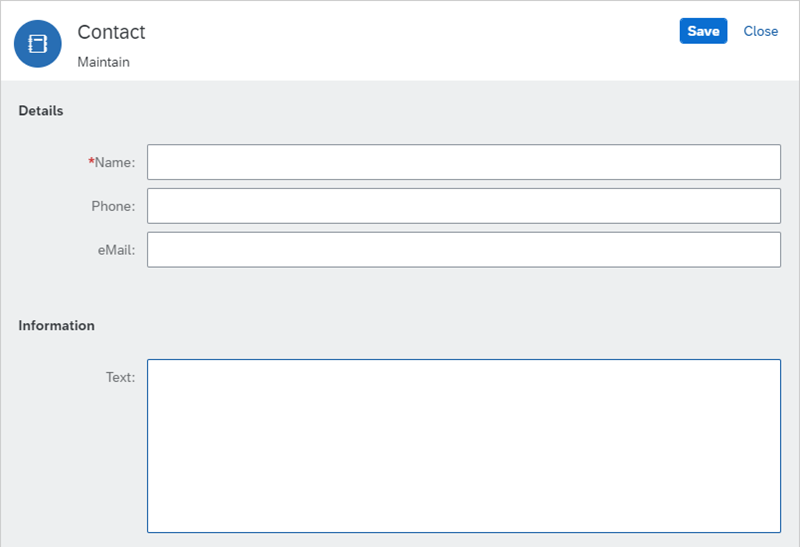Adaptive edit
The adaptive edit template provides functionalities to create adaptive applications in the Adaptive Designer based on predefined data sources.
In the resulting adaptive application, you can create and update data sets in a form-like display.
Optionally, you can link adaptive applications created with the adaptive edit template to adaptive applications created with the adaptive list template.

Image insertion
To insert an image for a field in a form, in the Settings/properties pane, you can select an input field as the type Image.
If you enter an image source for the image in the input field, you enable a preview of the image, which can be enlarged. If you enter no image source for the image, the image preview is hidden.
You can modify the following settings:
- Hide Input Field
-
Select to hide the input field for the image source. If the input field contains an image source, when a form based on an adaptive edit template is opened from another app, the inserted image is displayed without displaying the image source.
- Image Height
-
Enter a height for the image. The default height is 200px. When you enter an image height, the image width is adjusted dynamically to display the correct aspect ratio for the image.
Number Custom Decimals setting
In adaptive applications using the adaptive edit template, you can customize the display of numerical values with decimal places. In the Values section of the Settings/properties pane, select Number Custom Decimals from the Formatter field.
To control the number of decimal places of a numerical value, enter a value in the Decimals field. To format the decimal separator of a numerical value according to regional formatting standards or for compatibility, in the Decimal separator field, choose between Browser Default, Comma, Point.
Input mask setting
For fields where a specific format for entry is required like, for example, a postal code or phone number, you can use the input mask setting to constrain the information to be entered to the required format.
The input mask setting is valid for the fields of type DatePicker, DateTimePicker,
Input, and MultiSelect Lookup.
The Mask section contains the following settings:
- Input Mask
-
Enter a mask input that applies to the field when set.
Example:
* * * - * * * - * * *: By default, a user can enter any characters that are alphabetical (A-Z, uppercase or lowercase) or numerical (0-9) and these characters are formatted accordingly in the field, for example,123-456-789(with the inclusion of the dashes). - Enable Mask Rule
-
Select to enable the following advanced input mask settings:
- Mask Character
-
Sets which character should be considered the placeholder character. The default character is an asterisk (*).
- Mask Rule
-
The mask rule constrains the input to a specific selection. You can select the following mask rules:
-
All letters and numbers
-
Only numbers 0-9
-
Only letters
-
Only uppercase letters
-
Only lowercase letters
-
Custom Regex
-
- Custom Regex
-
If, in Mask Rule, you select Custom Regex, you can specify a custom regex as a character combination as required by your use case.
Conditional Visibility settings
To control whether to show or hide a field in the adaptive edit template, in the Properties section of the Settings/properties pane, you can select the Visible checkbox.
If you select the Visible checkbox, you enable the Conditional Visibility section of the Settings/properties pane.
With conditional visibility, you can dynamically control when to show or hide elements based on specific criteria, for example, to hide buttons based on a specific user input.
The Operator field contains the option Is Empty that checks whether or not the selected field has a value. If you select Is Empty, you hide the Conditional Visibility fields Fixed Value and System Variable as you cannot enter or choose a fixed value or system variable, if the selected field is empty.
System variables as default values
For fields of forms in the adaptive edit template, in the Default Value section, you can select system variables in the System Variable field. The system variables you can select in the adaptive edit template correspond to the system variables Username and Name as they are defined in the User tool.
Value Help setting
For an input field to source a predefined set of values, in the Settings/properties pane, select the field type in Type to ValueHelp.
In the ValueHelp Source section that appears, to select an application, adaptive application, or a server script that contains the predefined values to filter between, select Settings. In Field to Return, enter the field name from the other application, adaptive application, or the property name from the server script to be referenced to populate the input field.
To prevent users from manually entering data in the input field for the user to only select the predefined values in the linked data, select Value Help Only.